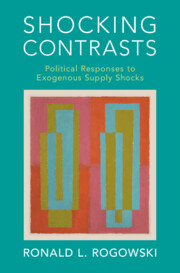Book contents
- Shocking Contrasts
- Political Economy of Institutions and Decisions
- Shocking Contrasts
- Copyright page
- Dedication
- Epigraph
- Contents
- Figures
- Maps
- Tables
- Preface and Acknowledgments
- Introduction
- 1 How Supply Shocks Arise and Why Political Responses to Them Vary
- 2 Who Adjusts to a Supply Shock and Who Resists It
- 3 Why a Technological Solution Does, or Does Not, Emerge
- 4 Exogenous Loss of Labor
- 5 Exogenous Gain of Labor: Railroads, Reproduction, and Revolution
- 6 Exogenous Loss of Land
- 7 Exogenous Increase of Human Capital
- 8 When the Endogenous Becomes Exogenous
- 9 Conclusion
- References
- Index
- Other books in the series (continued from page iii)
4 - Exogenous Loss of Labor
The Black Death in Fourteenth-Century Europe
Published online by Cambridge University Press: 09 June 2023
- Shocking Contrasts
- Political Economy of Institutions and Decisions
- Shocking Contrasts
- Copyright page
- Dedication
- Epigraph
- Contents
- Figures
- Maps
- Tables
- Preface and Acknowledgments
- Introduction
- 1 How Supply Shocks Arise and Why Political Responses to Them Vary
- 2 Who Adjusts to a Supply Shock and Who Resists It
- 3 Why a Technological Solution Does, or Does Not, Emerge
- 4 Exogenous Loss of Labor
- 5 Exogenous Gain of Labor: Railroads, Reproduction, and Revolution
- 6 Exogenous Loss of Land
- 7 Exogenous Increase of Human Capital
- 8 When the Endogenous Becomes Exogenous
- 9 Conclusion
- References
- Index
- Other books in the series (continued from page iii)
Summary
The Black Death of the fourteenth century reduced Europe’s population by about two-thirds between 1348 and 1420. Since endowments of land and capital remained unchanged, standard economic theory predicts rising real wages, falling rents of land and capital, and hence a drastic reduction of economic inequality. All of this occurred in most of western Europe. Elites eventually yielded, serfdom ended, landowners shifted from labor- to land-intensive production (grazing displaced planting), and labor-saving inventions abounded. In Europe east of the Elbe, by contrast, a formerly free peasantry was reduced to serfdom and landowners specialized increasingly in grain production, much of it for export. A plausible reason for the divergent responses is soil and climate: western Europe was mostly suitable for sedentary animal husbandry, eastern Europe was not; and the two were separated by a sharp dividing line that lay only slightly west of the Elbe. Data on Prussian landholdings suggest a strong correlation between low suitability for animal husbandry and the prevalence of serf-cultivated estates. Western elites could engage in factor substitution; eastern ones could not.
Keywords
- Type
- Chapter
- Information
- Shocking ContrastsPolitical Responses to Exogenous Supply Shocks, pp. 55 - 82Publisher: Cambridge University PressPrint publication year: 2023



